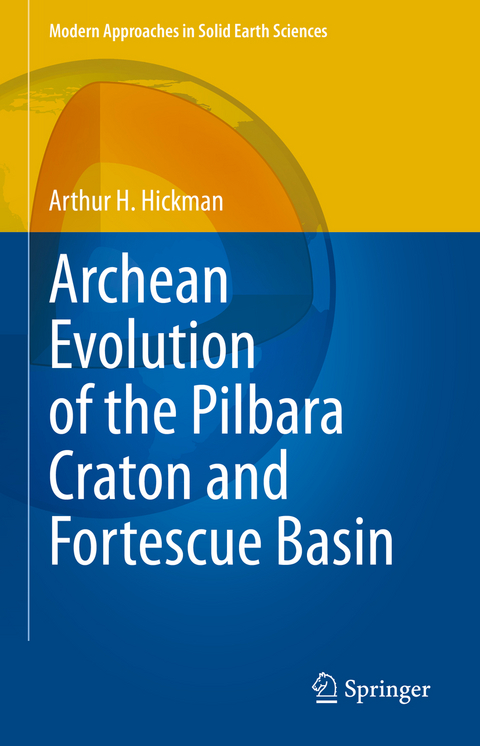
Archean Evolution of the Pilbara Craton and Fortescue Basin
Springer International Publishing (Verlag)
978-3-031-18005-7 (ISBN)
The Pilbara region of northwest Australia is internationally famous for its abundant and exceptionally well-preserved fossil evidence of early life. However, until recently the area has received much less recognition for the key evidence it provides on early Archean crustal evolution. This book presents and interprets this evidence through a new stage-by-stage account of the development of the Pilbara's geological record between 3.53 and 2.63 Ga.
The Archean Pilbara crust represents one fragment of Earth's oldest known supercontinent Vaalbara, which also included the Kaapvaal Craton of southern Africa. Recognition of Vaalbara expands the background database for both these areas, allowing us to more fully understand each of them.
Arthur Hugh Hickman joined the Geological Survey of Western Australia (GSWA) early in 1972 shortly after being awarded a PhD (Geology) at Birmingham University, England. His interpretations of the stratigraphy, structure, and geochemistry of 800 km2 of the Southwest Highlands of Scotland were subsequently published in UK journals between 1975 and 1983. Parts of his geological mapping were incorporated into maps produced by the British Geological Survey. Arthur's main aim during his first 20 years at GSWA was to contribute to increasing the geological understanding of parts of the vast state of Western Australia. His initial investigations covered the 100,000 km2 Pilbara region, and after a few years Arthur wrote a book (GSWA Bulletin 127) providing the first comprehensive interpretation of this area's stratigraphy, crustal evolution, and mineralization. GSWA priorities then moved his investigations to other parts of Western Australia, but in 1993 a project was set up for a more detailed geological study of the Pilbara. The Pilbara Craton Mapping Project was conducted jointly between GSWA and Geoscience Australia between 1994 and 2005. The project was focused on more detailed geological mapping, with the GSWA Pilbara team quickly expanding to eight geoscientists under Arthur's management. After 2005, members of the Pilbara team were moved to other projects and Arthur commenced follow-up compilation of maps and reports, geological interpretations, and working to make the large volume of data from the project more accessible in digital format. During his 50-year career with GSWA, Arthur has led many local and international geological excursions to the Pilbara and is recognized as a leading authority on the geology of this scientifically important area. He has published widely, and has given presentations to international audiences in Australia, South Africa, Japan, and USA.
Chapter 1. Overview Of The Pilbara Craton.- Chapter 2. Eoarchean And Early Paleoarchean Crust Of The Pilbara Craton.- Chapter 3. Warrawoona Large Igneous Province, 3530-3427 Ma.- Chapter 4. Strelley Pool Formation: Continental Sedimentation Between Paleoarchean Lips.- Chapter 5. Kelly Large Igneous Province, 3350-3315 Ma.- Chapter 6. Paleoarchean Continental Breakup Of The Pilbara Craton.- Chapter 7. Mesoarchean Rift And Marginal Basins Of The Pilbara Craton.- Chapter 8. Mesoarchean Subduction In The Pilbara Craton.- Chapter 9. Mesoarchean Basin Evolution Inland Of Magmatic Arcs.- Chapter 10. Orogenies, Cratonization And Post-Orogenic Granites.- Chapter 11. Mineralization In The Northern Pilbara.- Chapter 12. Fortescue Group: The Neoarchean Breakup Of The Pilbara Craton.
| Erscheinungsdatum | 11.03.2023 |
|---|---|
| Reihe/Serie | Modern Approaches in Solid Earth Sciences |
| Zusatzinfo | XLV, 465 p. 144 illus., 118 illus. in color. |
| Verlagsort | Cham |
| Sprache | englisch |
| Maße | 155 x 235 mm |
| Gewicht | 925 g |
| Themenwelt | Naturwissenschaften ► Geowissenschaften ► Geologie |
| Naturwissenschaften ► Geowissenschaften ► Geophysik | |
| Schlagworte | Archean Greenstone • Crustal evolution • Early Life • Pilbara Craton • Vaalbara |
| ISBN-10 | 3-031-18005-4 / 3031180054 |
| ISBN-13 | 978-3-031-18005-7 / 9783031180057 |
| Zustand | Neuware |
| Haben Sie eine Frage zum Produkt? |
aus dem Bereich


